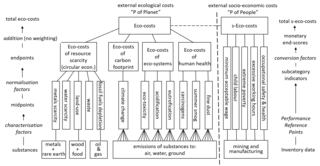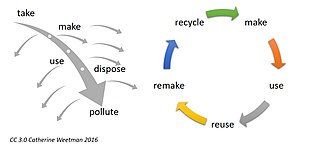Industrial ecology (IE) is the study of material and energy flows through industrial systems. The global industrial economy can be modelled as a network of industrial processes that extract resources from the Earth and transform those resources into commodities which can be bought and sold to meet the needs of humanity. Industrial ecology seeks to quantify the material flows and document the industrial processes that make modern society function. Industrial ecologists are often concerned with the impacts that industrial activities have on the environment, with use of the planet's supply of natural resources, and with problems of waste disposal. Industrial ecology is a young but growing multidisciplinary field of research which combines aspects of engineering, economics, sociology, toxicology and the natural sciences.
Life-cycle assessment is a technique to assess environmental impacts associated with all the stages of a product's life from raw material extraction through materials processing, manufacture, distribution, use, repair and maintenance, and disposal or recycling. Designers use this process to help critique their products. LCAs can help avoid a narrow outlook on environmental concerns by:
Over the years, as countries and regions around the world began to develop, it slowly became evident that industrialization and economic growth come hand in hand with environmental degradation. Eco-Efficiency has been proposed as one of the main tools to promote a transformation from unsustainable development to one of sustainable development. It is based on the concept of creating more goods and services while using fewer resources and creating less waste and pollution. “It is measured as the ratio between the (added) value of what has been produced and the (added) environment impacts of the product or service .” The term was coined by the World Business Council for Sustainable Development (WBCSD) in its 1992 publication “Changing Course,” and at the 1992 Earth Summit, eco-efficiency was endorsed as a new business concept and means for companies to implement Agenda 21 in the private sector. Ergo the term has become synonymous with a management philosophy geared towards sustainability, combining ecological and economic efficiency.
Social impact assessment (SIA) is a methodology to review the social effects of infrastructure projects and other development interventions. Although SIA is usually applied to planned interventions, the same techniques can be used to evaluate the social impact of unplanned events, for example disasters, demographic change and epidemics.
Environmental accounting is a subset of accounting proper, its target being to incorporate both economic and environmental information. It can be conducted at the corporate level or at the level of a national economy through the System of Integrated Environmental and Economic Accounting, a satellite system to the National Accounts of Countries.
Ecodesign is an approach to designing products with special consideration for the environmental impacts of the product during its whole lifecycle. In a life cycle assessment, the life cycle of a product is usually divided into procurement, manufacture, use, and disposal.
Carbon accounting refers generally to processes undertaken to "measure" amounts of carbon dioxide equivalents emitted by an entity. It is used by states, corporations and individuals to create the carbon credit commodity traded on carbon markets. Correspondingly, examples for products based upon forms of carbon accounting can be found in national inventories, corporate environmental reports or carbon footprint calculators. Likening sustainability measurement, as an instance of ecological modernisation discourses and policy, carbon accounting is hoped to provide a factual ground for carbon-related decision-making. However, social scientific studies of accounting challenge this hope, pointing to the socially constructed character of carbon conversion factors or of the accountants' work practice which cannot implement abstract accounting schemes into reality.
Design for the Environment (DfE) is a design approach to reduce the overall human health and environmental impact of a product, process or service, where impacts are considered across its life cycle. Different software tools have been developed to assist designers in finding optimized products or processes/services. DfE is also the original name of a United States Environmental Protection Agency (EPA) program, created in 1992, that works to prevent pollution, and the risk pollution presents to humans and the environment. The program provides information regarding safer chemical formulations for cleaning and other products. EPA renamed its program "Safer Choice" in 2015.
Product-service systems (PSS) are business models that provide for cohesive delivery of products and services. PSS models are emerging as a means to enable collaborative consumption of both products and services, with the aim of pro-environmental outcomes.
Whole-life cost, or Life-cycle cost (LCC), refers to the total cost of ownership over the life of an asset. Also commonly referred to as "cradle to grave" or "womb to tomb" costs. Costs considered include the financial cost which is relatively simple to calculate and also the environmental and social costs which are more difficult to quantify and assign numerical values. Typical areas of expenditure which are included in calculating the whole-life cost include planning, design, construction and acquisition, operations, maintenance, renewal and rehabilitation, depreciation and cost of finance and replacement or disposal.
Policy Impact Assessments (IAs) are formal, evidence-based procedures that assess the economic, social, and environmental effects of public policy. They have been incorporated into policy making in the OECD countries and the European Commission.
Urban metabolism is a model to facilitate the description and analysis of the flows of the materials and energy within cities, such as undertaken in a material flow analysis of a city. It provides researchers with a metaphorical framework to study the interactions of natural and human systems in specific regions. From the beginning, researchers have tweaked and altered the parameters of the urban metabolism model. C. Kennedy and fellow researchers have produced a clear definition in the 2007 paper The Changing Metabolism of Cities claiming that urban metabolism is "the sum total of the technical and socio-economic process that occur in cities, resulting in growth, production of energy and elimination of waste." With the growing concern of climate change and atmospheric degradation, the use of the urban metabolism model has become a key element in determining and maintaining levels of sustainability and health in cities around the world. Urban metabolism provides a unified or holistic viewpoint to encompass all of the activities of a city in a single model.
An economic input-output life-cycle assessment, or EIO-LCA involves the use of aggregate sector-level data to quantify the amount of environmental impact that can be directly attributed to each sector of the economy and how much each sector purchases from other sectors in producing its output. Combining such data sets can enable accounting for long chains, which somewhat alleviates the scoping problem of traditional Life-cycle assessments. EIO-LCA analysis traces out the various economic transactions, resource requirements and environmental emissions required for producing a particular product or service.

Eco-costs are the costs of the environmental burden of a product on the basis of prevention of that burden. They are the costs which should be made to reduce the environmental pollution and materials depletion in our world to a level which is in line with the carrying capacity of our earth.

A circular economy is an economic system aimed at minimising waste and making the most of resources. This regenerative approach is in contrast to the traditional linear economy, which has a 'take, make, dispose' model of production. In a circular system resource input and waste, emission, and energy leakage are minimized by slowing, closing, and narrowing energy and material loops; this can be achieved through long-lasting design, maintenance, repair, reuse, remanufacturing, refurbishing, and recycling, all implemented via corporate and social entrepreneurship. Proponents of the circular economy suggest that a sustainable world does not mean a drop in the quality of life for consumers, and can be achieved without loss of revenue or extra costs for manufacturers. The argument is that circular business models can be as profitable as linear models, allowing us to keep enjoying similar products and services.
Thomas Lindhqvist is a Swedish academic. He is credited for introducing the concept of extended producer responsibility. He is currently Associate Professor and Director of Research Programs at the International Institute for Industrial Environmental Economics at Lund University in Sweden
MuSIASEM or Multi-Scale Integrated Analysis of Societal and Ecosystem Metabolism, is a method of accounting used to analyse socio-ecosystems and to simulate possible patterns of development. It is based on maintaining coherence across scales and different dimensions of quantitative assessments generated using different metrics. It is designed to detect and analyze patterns in the societal use of resources and the impacts they create on the environment. The approach was created around 1997 by Mario Giampietro and Kozo Mayumi, and has been developed since then by the members of the IASTE group at the Institute of Environmental Science and Technology of the Universitat Autònoma de Barcelona and its external collaborators. MuSIASEM strives to characterize metabolic patterns of Socio-Ecological Systems. This integrated approach allows for a quantitative implementation of the DPSIR framework and application as a decision support tool. Different alternatives of the option space can be checked in terms of feasibility, viability and desirability. The ability to integrate quantitative assessments across dimensions and scales makes MuSIASEM particularly suited for different types of sustainability analysis: (i) the nexus between food, energy, water and land uses; (ii) urban metabolism; (iii) waste metabolism; (iv) tourism metabolism; (v) rural development.
Henrik Wenzel is a Danish engineer and head of SDU Life Cycle Engineering at University of Southern Denmark (SDU).
Alternatives assessment or alternatives analysis is a problem-solving approach used in environmental design, technology, and policy. It aims to minimize environmental harm by comparing multiple potential solutions in the context of a specific problem, design goal, or policy objective. It is intended to inform decision-making in situations with many possible courses of action, a wide range of variables to consider, and significant degrees of uncertainty. Alternatives assessment was originally developed as a robust way to guide precautionary action and avoid paralysis by analysis; authors such as O'Brien have presented alternatives assessment as an approach that is complementary to risk assessment, the dominant decision-making approach in environmental policy. Likewise, Ashford has described the similar concept of technology options analysis as a way to generate innovative solutions to the problems of industrial pollution more effectively than through risk-based regulation.

Edeltraud Günther is a German economist and since 1996 professor at the Chair of Business Management, esp. Environmental Management and Accounting at the TU Dresden.



